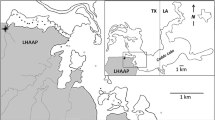Abstract
The ability of whole effluent toxicity (WET) tests to predict in-stream effects to periphyton, benthic macroinvertebrates, and fish in a habitat-impaired stream was assessed. Habitat assessment data were useful in interpreting in-stream conditions for periphyton and benthic macroinvertebrates. Various periphyton and macroinvertebrate metrics identified siltation effects as opposed to water quality effects in-stream. Pathogen effects noted in fathead minnow WET tests were not reflected in the fish community. Overall, in-stream biological conditions confirmed the absence of water quality-related effects as predicted by WET tests.

Similar content being viewed by others
References
APHA, AWWA, WEF (1992) Standard methods for the examination of water and wastewater, 18th edn. American Public Health Assoc, Washington, DC
Ausley LW (2000) Reflection on whole effluent toxicity: the pellston workshops. Environ Toxicol Chem 19:1–2. doi:10.1897/1551-5028(2000)019<0001:ROWETT>2.3.CO;2
Bahls LL (1993) Periphyton bioassessment methods for montana streams. Water Quality Bureau, Montana Department of Health and Environmental Sciences, Helena Montana January 1993
DeVlaming V, Connor V, DiGiorgio C, Bailey HC, Deanovic LA, Hinton DE (2000) Application of whole effluent toxicity test procedures to ambient water quality assessment. Environ Toxicol Chem 19:42–62. doi:10.1897/1551-5028(2000)019<0042:AOWETT>2.3.CO;2
Diamond J, Daley C (2000) What is the relationship between whole effluent toxicity and in-stream biological condition? Environ Toxicol Chem 19:158–168. doi:10.1897/1551-5028(2000)019<0158:WITRBW>2.3.CO;2
Diamond J, Stribling J (2007) Evaluation of wet testing as an indicator of aquatic ecosystem health in effluent-dominated streams: a pilot study. Water Environment Research Federation Report 03-ECO-2T, Alexandria, VA
Downey PJ, Fleming K, Guinn R, Chapman N, Varner P, Cooney JD (2000) Sporadic mortality in chronic toxicity tests using Pimephales promelas (rafinesque): cases of characterization and control. Environ Toxicol Chem 19:248–255. doi:10.1897/1551-5028(2000)019<0248:SMICTT>2.3.CO;2
Eagleson KE, Lenat DL, Ausley LW, Winborne FG (1990) Comparison of measured in-stream biological responses with responses predicted using the ceriodaphnia chronic toxicity test. Environ Toxicol Chem 9:1019–1028. doi:10.1897/1552-8618(1990)9[1019:COMIBR]2.0.CO;2
Geis SW, Fleming K, Mager A, Reynolds L (2003) Modifications to the fathead minnow (Pimephales promelas) chronic test method to remove mortality due to pathogenic organisms. Environ Toxicol Chem 22:2400–2404. doi:10.1897/02-375
Grothe DR, Johnson DE (1996) Bacterial interference in whole effluent toxicity tests. Environ Toxicol Chem 15:761–764. doi:10.1897/1551-5028(1996)015<0761:SCBIIW>2.3.CO;2
Kszos LA, Stewart AJ, Sumner JR (1997) Evidence that variability in ambient fathead minnow short-term chronic tests is due to pathogenic interefernce. Environ Toxicol Chem 16:351–356. doi:10.1897/1551-5028(1997)016<0351:ETVIAF>2.3.CO;2
Lenat DR (1993) Development of a hilsenhoff-type biotic index for North Carolina, with tolerance values for southeastern stream macroinvertebrates. J North Am Benthol Soc 12:279–290. doi:10.2307/1467463
TDEC (2003) Quality system standard operating procedure for macroinvertebrate stream surveys. State of Tennessee Department of Environment and Conservation. Division of Water Pollution Control. March 2002 Revised November 2003
USEPA (1999) Rapid bioassessment protocols for use in wadeable streams and rivers – Periphyton, Benthic macroinvertebrates, and Fish, 2nd edn. United States Environmental Protection Agency, Office of Water, Washington, D.C EPA/841-B-99-002
USEPA (2002) Short-term methods for estimating the chronic toxicity of effluents and receiving waters to freshwater organisms, 4th edn. United States Environmental Protection Agency, Office of Water, Washington, D.C EPA-821-R-02-013
Acknowledgement
Special thanks to The Goodyear Tire and Rubber Company for funding this research.
Author information
Authors and Affiliations
Corresponding author
Rights and permissions
About this article
Cite this article
Hall, S., Beeson, D., Kinsey, M. et al. Assessing the Relationship Between Laboratory Whole Effluent Toxicity Test Data and In-Stream Biological Communities. Bull Environ Contam Toxicol 82, 270–274 (2009). https://doi.org/10.1007/s00128-008-9607-2
Received:
Accepted:
Published:
Issue Date:
DOI: https://doi.org/10.1007/s00128-008-9607-2




